Pelvic Tilt
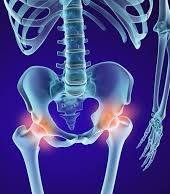
Pelvic tilt is often a complex issue, involving both the spine & the hips, & can occur alongside spinal & hip deformities eg. spina bifida which may further progress any scoliosis.
Pelvic tilt is an imbalance in the orientation of the pelvis, related to various muscles in the legs & back, eg. hip extensors, such as the hamstrings & glutes, & hip flexors, such as the quads, iliac & psoas muscles.
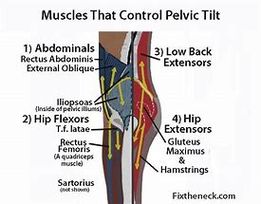
These muscles will place a slight strain on the pelvis even when not in use, but there should be a balance between the pressure & force from each side, meaning that the back & the pelvis stay aligned. An imaginary line drawn across the top of the pelvis should be parallel to the floor.
The pelvic girdle links the thighs to the base of the spine, & is therefore important for stability, movement, & posture. When muscle imbalances occur, the pelvis can tilt backward, forwards or to either side of the body, & the following abnormalities can arise:-
⦁ abnormal alignment of the sacroiliac joint
⦁ abnormal alignment of the lumbar spine - may cause early spinal degeneration & low back pain
The hips generate power in athletic activities like sprinting, deadlifting & jumping, so any potential condition that may deform the pelvis, eg pelvic tilt will affect physical ability.
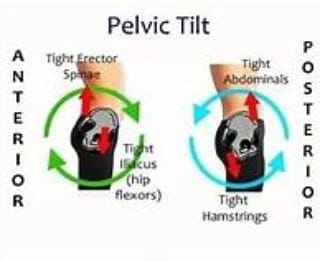
SYMPTOMS OF PELVIC TILT
⦁ malalignment & degeneration of the sacroiliac joint & the lumbar spine
⦁ pain
⦁ difficult mobilisation
⦁ severe low back pain
⦁ hip pain
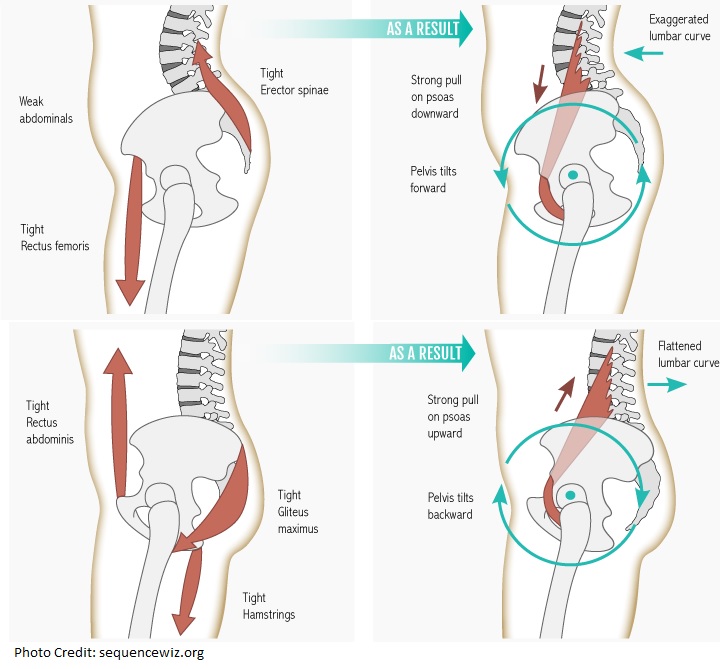
COMPLICATIONS OF PELVIC TILT If untreated :-
⦁ back pain
⦁ muscle pain
⦁ shoulder pain
⦁ neck pain
⦁ headaches
⦁ joint & knee pain
HOW TO CORRECT PELVIC TILT
Mild cases can be treated by correcting your sitting posture & increasing physical activity but more severe cases may require input from a sports therapist or physiotherapist.
⦁ WALKING - the simplest way to correct pelvic tilt by strengthening the abdominal muscles, hamstrings, & glutes. It also stretches the quads & hip flexors
⦁ POSTURE - correcting your posture when sitting & standing, with the chest up, shoulders back, the back straight & feet shoulder width apart
⦁ MASSAGE - particularly sports massage :-
1. improves blood circulation which may be restricted due to muscle tightness & pelvic tilt
2. relaxes the muscles & therefore treats the symptoms caused by pelvic tilt eg chronic back pain
3. helps to correct muscle imbalances by relaxes tight muscles such as quads & the psoas muscles which contribute to pelvic tilt
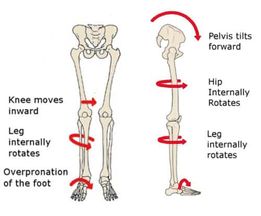
⦁ EXERCISES
- there are exercises specifically for correcting pelvic tilt, which will be devised by a therapist who will assess the extent of the tilt.
These exercises will stretch & relax tight muscles, improving the balance between opposing muscle groups eg. the hamstrings & quads. The tension in the pelvis becomes balanced, thus reducing the tilt.
ANTERIOR PELVIC TILT
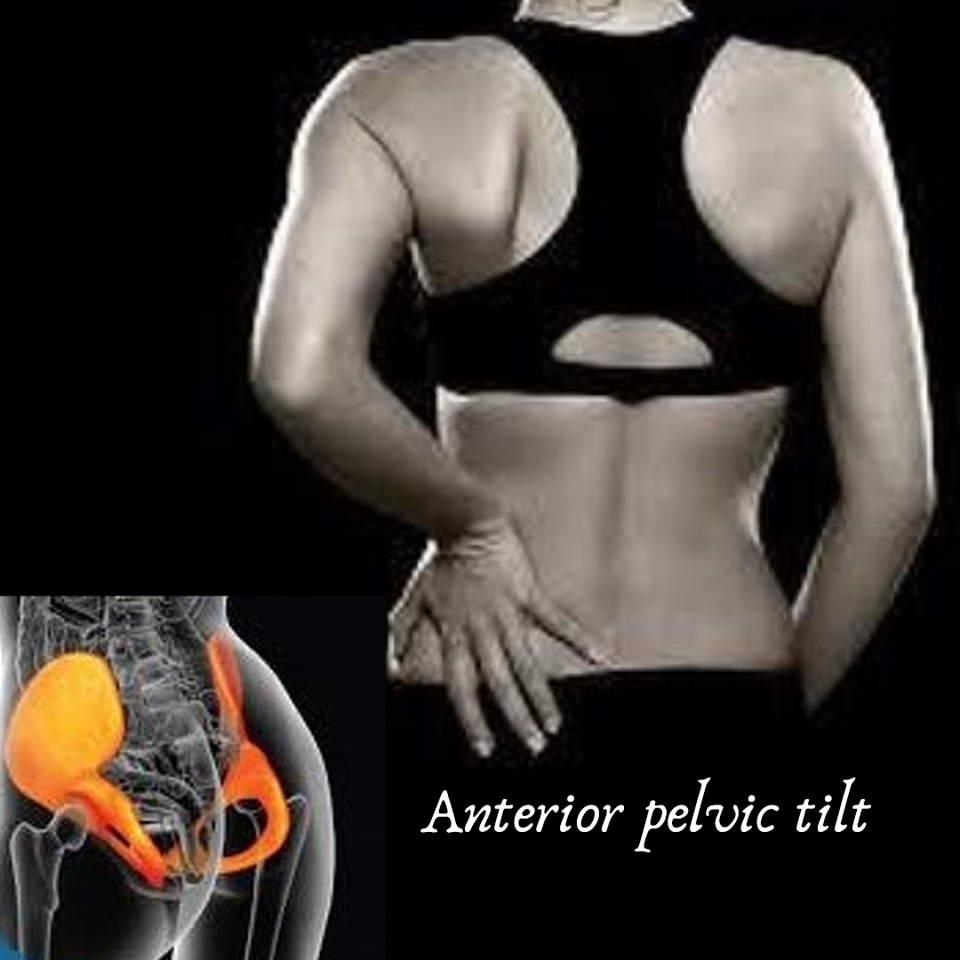
⦁ pelvis slightly points downwards at the front with the back rising upwards
⦁ results in:-
1. protruding buttocks
2. an exaggerated lumbar curve
3. a protruding stomach
4. a decrease in height
5. the upper body may also round a little to balance the body, causing the head to jut forward & shoulders stooped
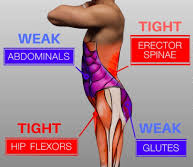
⦁ commonly caused by an imbalance in the legs, hips, buttocks, back & stomach muscles in terms of flexibility, strength, & length
⦁ generally due to tight quads, psoas & erector spinae muscles
⦁ imbalance may be caused by too much time sitting which weakens the glutes & shortens the psoas
⦁ imbalance may be caused by working out in uneven postures for longer periods
⦁ if not addressed can lead to trigger point formation causing:-
1. hip pain due to rotated femurs
2. lower back pain
3. knee pain as a result of the knock-knee position
4. flat feet
5. shoulder pain
6. headaches
7. neck pain
EXERCISES
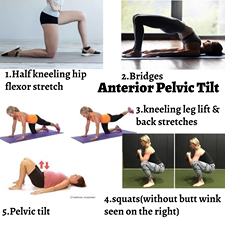
1)HALF-KNEELING HIP FLEXOR STRETCH
• Step forward with left leg & lunge until the right knee is resting on the ground. Your left leg should make a 90-degree angle at your knee
• bring the pelvis forward by tightening your glutes & abdominal muscles
• lean forward from the right leg until you feel tension in the hip flexor and inner thigh of your right leg
• hold for 30 seconds, release, & repeat x 5 • switch legs
2.BRIDGE
• strengthen your hamstrings & glutes
• lie flat on your back with legs bent & feet flat on the floor, hip-width apart, arms by your sides
• push heels into the floor as you lift your pelvis up off the floor until your upper body & thighs form a straight line
• hold for 2 seconds, lower down slowly, and repeat x 8
• ensure you tighten your glutes & abdominal muscles while in this position to maintain a correct bridge alignment
3.KNEELING LEG LIFT WITH BACK STRETCH
• helps tighten abdominals & stretch back & glutes
• kneel on your hands and knees
• place hands on the floor shoulder-width apart & align your hips with your knees
• ensure your back is parallel to the ground so your pelvis is in a neutral position
• pull your belly button in toward your spine & arch your back as you exhale
• hold for 2 seconds, & then bring your spine back to the neutral position
• extend one leg back & lift it until it reaches the same height as your body, so your lifted leg & body are in alignment, keeping your spine in a neutral position
• hold for up to 5 seconds, lower the leg, & repeat x 10
• switch legs
4.SQUATS
• helps strengthen the glutes, hamstrings, & quads, among others
• place feet shoulder-width apart, toes pointing forward
• lower to a sitting position until thighs are parallel to the floor. Make sure you’re keeping your abs tight & your back in a neutral position
• push up to a standing position & move your pelvis slightly forward by tightening your glutes
• repeat x 15 Don’t let your knees go over your toes or rotate inward. Keep your back in a neutral position. Do not flatten the curve of your lower back or overly arch your back. Squeeze your abdominals & glutes. Look straight ahead.
5.PELVIC TILT
• helps strengthen abdominal muscles, & stretches your lower back
• lie with your back on the floor in a neutral position with your legs bent & toes facing forward
• pull your belly button in toward your spine, pushing your pelvis up toward the ceiling
• tighten your glutes & hip muscles as you tilt your pelvis forward. Hold for 5 seconds.
• do 5 sets x 20
POSTERIOR PELVIC TILT
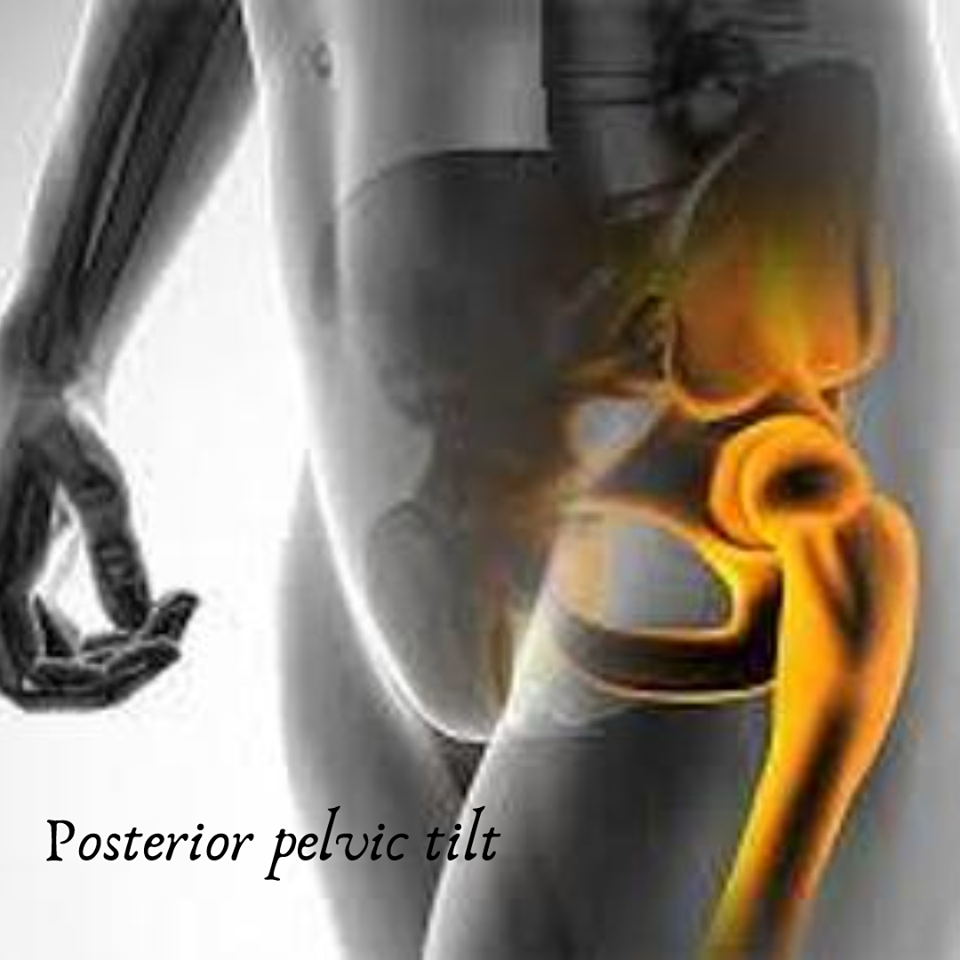
⦁ the back of the pelvis lowers & the front rises
⦁ due to lengthening of the hip flexors & the shortening of the hip extensors, particularly the gluteus maximus
⦁ tight hamstrings & abdominal muscles, as well as weak psoas, quads, & lower back muscles can cause posterior pelvic tilt
⦁ slouching sitting positions can distort the spine resulting in posterior pelvic tilt
⦁ not as common as anterior pelvic tilt
⦁ usually occurs in gym-goers who focus too much on their hamstrings, glutes & abdominal muscles eg. leg presses & straight leg deadlifts may cause the hamstrings & glutes to tighten more than the quads & psoas
⦁ causes loss of curvature in the spine.
⦁ the cervical & the thoracic segments are pushed forward
⦁ people may appear stooped over
⦁ may cause a disc herniation due to increased pressure on the disc which may irritate the nerves & cause sciatica
EXERCISES FOR POSTERIOR TILT
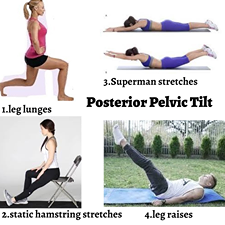
1.LEG LUNGES
• build up your glutes, quads, & hamstrings, helping to correct a posterior tilt by preventing any one muscle from dominating
• stand with feet together & step your right leg out in front of you • bend the right leg at a 90-degree angle. Your other knee should touch the floor with your right leg still at a 90-degree angle. A mirror can help you check your position. Push off your right foot to return to the starting position.
• step forward with your left leg & form a 90-degree angle to touch your right knee to the floor.
• repeat for 3 sets x 10–15 Do not bend your knees past your toes, which can hurt your knees. If you have knee problems, you may want to work on other leg exercises instead.
2.STATIC HAMSTRING STRETCH
• sitting/standing for long periods can cause tight hamstrings, which may lead to bad posture
• sit in a hard chair without a cushion, & stretch out one leg in front of you
• bend down & reach for your toes until you feel a slight stretch
• hold for 10–30 seconds
• switch to the other leg & repeat on the other side If you go down too far into the stretch you can pull your back. If a chair is too difficult for you, try moving this exercise to the floor.
3.SUPERMAN STRETCH
• can help strengthen your lower back & glutes
• lie on the floor on your stomach & stretch your arms out in front of you
• lift your chest off the floor & try to hold that position for 30 seconds. Then lower.
• repeat 3 sets with a 10-second break in between
• If you have a bad back, it’s best to skip this exercise
4.LEG RAISES
• strengthen your core, improving posture
• lie flat on the floor with your legs straight. Slowly raise your legs as high as you can without allowing your lower back to arch off the floor
• slowly lower them back down, keeping your arms flat right next to your body
• try not to move any part of your body except for your legs. Your abdomen is doing all the work
LATERAL PELVIC TILT
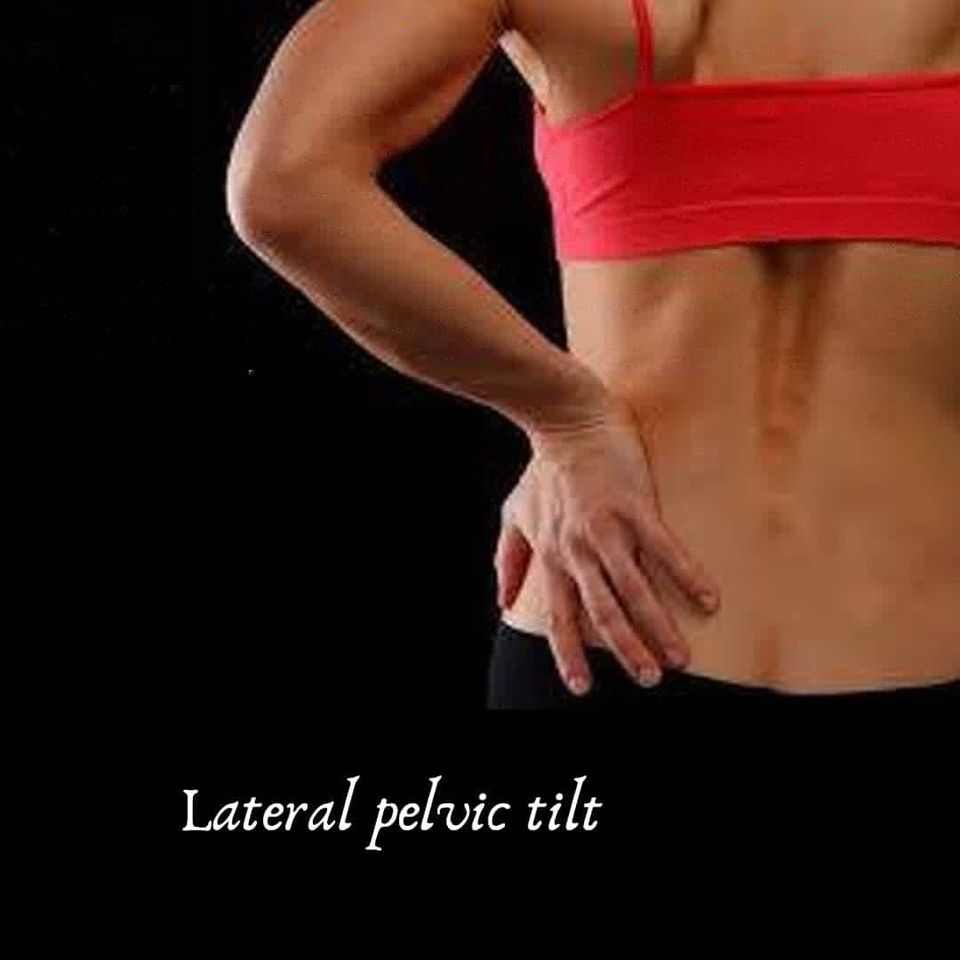
⦁ tilting of the hip to the right or left of the pelvis
⦁ usually associated with different leg length or scoliosis
⦁ can also be caused by one leg bending while the other remains straight in standing positions
⦁ causes the muscles involved to tilt, become imbalanced & cause back pain (the adductors, quadratus lumborum, and glute medius)
⦁ likely to develop disc degeneration, sacroiliac joint pain, muscles spasms & disc herniation
⦁ hip hiking occurs due to tense hip flexors, hip adductors, & quadratus lumborum - requires stretching the lower back & hip flexors & strengthening hip abductors
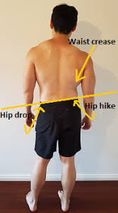
⦁ a dropped hip, on the other hand, is caused by weakened hip flexors & QL - requires strengthening of adductor & hip flexor muscles
CAUSES OF PELVIC TILT?
⦁ leg length discrepancy
⦁ flat feet
⦁ excessive pronation
⦁ working a sedentary job
⦁ abnormal posture
⦁ muscle imbalances
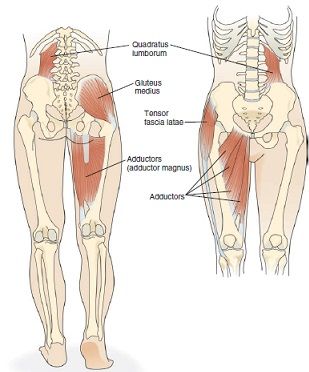
⦁ forms of exercise that result in uneven impact & pressure on the body
EXERCISES FOR LATERAL TILT
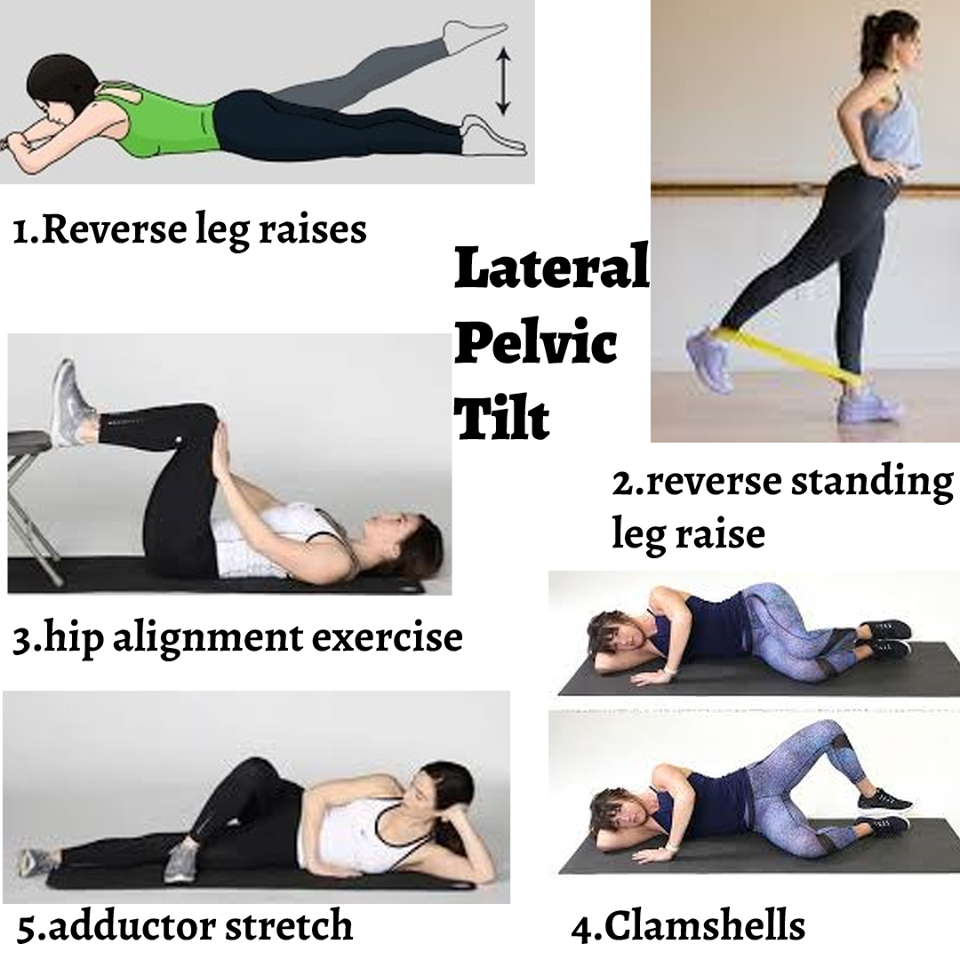
1. REVERSE LEG RAISES
• helps strengthen glutes & improve hip mobility. The hip that sits lower will probably have weaker muscles, which can make this exercise challenging at first.
• lie on your stomach with your legs resting on the ground & your forehead resting on your hands
• lift one leg while keeping your knees straight & glutes tightened. Do not allow the other hip to come up off the floor
• hold for 2- 5 seconds, & then lower your leg
• repeat x10
• switch legs Don’t arch your back as you lift your leg, squeeze your abdominal muscles to prevent arching too much
2. REVERSE STANDING LEG RAISES
• strengthens glutes & improves your balance
• hold onto a wall or the back of a chair for balance
• hold your body straight, tighten your abdominal muscles, & lift one leg off the ground behind you
• lift your leg straight behind you as high as you comfortably can without arching your back
• lower your leg until your toe is resting on the floor
• repeat x 10
• switch legs Do not swing your leg as that can cause back pain.
3. HIP REALIGNMENT
• helps bring your hips in line with each other
• lie on your back with your feet against a wall
• using the leg on the same side as the hip that is tilted toward your shoulder, press your leg into the wall
• at the same time, press your higher hip down with your hand
• hold for 10 seconds, and then release
• repeat x 10
4. CLAMSHELLS
• helps improve hip mobility & strengthen your glutes
• lie down on your side with both legs bent at a 90-degree angle, & your bottom arm supporting your head
• before you start, roll your top hip slightly forward toward the ground, making sure your spine is relaxed & stable
• lift your top knee up, but keep your feet together
• hold for 5 seconds, & then lower your knee • Repeat x 10
• switch sides Do not rotate your spine as this can cause additional tension & back pain. You can bring your legs closer to your body to stretch further.
5. HIP ADDUCTION
• helps strengthen your adductor muscles, on the inside of your thigh
• lie on one side with both legs stretched out, using your bottom arm to support your head
• cross your top leg over your bottom leg, placing the foot of the top leg on the floor in front of your knee of the bottom leg
• holding your bottom leg straight, lift it as far up as you comfortably can
• hold for 5 seconds, & then lower your leg
• repeat x10
• switch sides. Do not twist your hips while lifting your leg.
